Explore essential insights into survival foods, focusing on effective storage techniques, understanding shelf life, and mitigating risks. This guide provides practical advice for ensuring food safety and maximizing longevity in emergency preparedness scenarios.
Here’s a quick list of what’s covered in this post:
- Guide to Checking Quality and Safety (Shelf Stable Foods)
- Perishables and Semi-Perishables: How to Assess Freshness and Avoid Spoilage
- Commonly Stored Food & Their Shelf Life (by the numbers)
- The Infinite Shelf Life: Food Items and Their Uses
- Essential Guidelines for Proper Food Storage: Maximizing Safety and Freshness
- Survival Food Safety: Managing Risks and Ensuring Quality in Emergency Situations
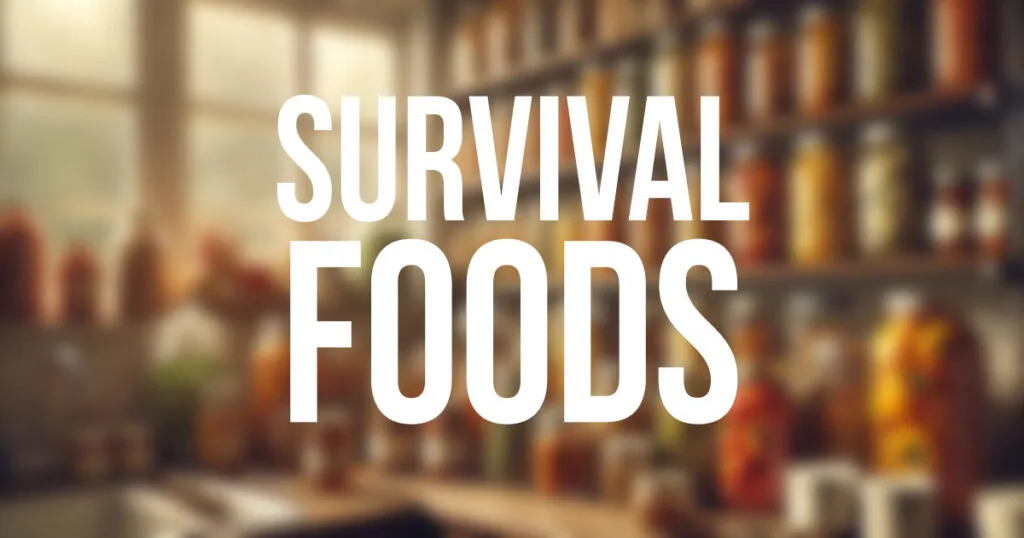
In a survival or prepping situation, the risks associated with consuming old or improperly stored food are heightened due to the lack of immediate medical care and the potential for weakened immune systems caused by stress and environmental factors. One of the primary risks is foodborne illness, which can be caused by bacteria such as Salmonella, E. coli, and Listeria, or by toxins produced by these organisms. These illnesses can lead to severe dehydration, especially dangerous in a survival scenario where access to clean water might be limited. Additionally, consuming old food can lead to nutrient deficiencies. Over time, essential vitamins and minerals in food can degrade, particularly in improperly stored conditions, leading to a lack of vital nutrients necessary for maintaining health and energy levels in challenging environments.
To mitigate these risks, it’s important to understand and implement safe food handling and storage practices. This includes keeping dry foods in airtight containers to prevent moisture and pest intrusion, and storing perishable items, like canned goods, in a cool, dry place to prevent spoilage. When evaluating food safety, prioritize non-perishable items like dried grains, beans, and powdered milk, which have longer shelf lives and are less likely to harbor harmful pathogens.
In the absence of expiration dates, rely on sensory checks – look for signs of spoilage like mold, off-odors, and changes in texture. In situations where refrigeration is not available, focus on consuming perishables first and rely on preservation methods like smoking, salting, or drying meats and produce to extend their usability. Remember, when in doubt, it’s safer to discard questionable food items than to risk serious illness in a survival situation.
Download the Printable
This PDF offers an in-depth exploration into survival foods, emphasizing the importance of understanding storage techniques, shelf life, and the risks associated with food preservation. The guide is comprehensive, covering a wide range of food types and offering practical advice for ensuring safety and maximizing food longevity, especially vital in emergency preparedness.
2 Ways to Get the Printable PDF:
1.) You can purchase the PDF download for $10 by clicking this button:
2.) You can join our Patreon ($5/mo) and get ALL PDF downloads + answers to all your questions, click the image:

Key Sections of the Guide:
- Quality and Safety in Shelf-Stable Foods: This section provides specific checks for canned goods, dried beans, grains, powdered milk, nuts, and more, outlining how to assess their safety and quality.
- Handling Perishables and Semi-Perishables: Offers tips on assessing the freshness of items like fresh fruits, vegetables, cheeses, and meats, and how to avoid spoilage.
- Shelf Life of Commonly Stored Foods: A detailed list showing the recommended and actual shelf lives of various foods, from canned vegetables to instant coffee.
- Foods with Indefinite Shelf Life: Discusses 15 items that not only last indefinitely but also serve multiple practical purposes, like honey, bottled water, and vinegar.
- Essential Guidelines for Proper Food Storage: Offers basic rules for storing dry goods, canned goods, perishables, and frozen foods to maintain quality and safety.
- Survival Food Safety: This section details the risks associated with consuming old or improperly stored food and strategies to mitigate these risks, including proper storage, rotation of supplies, and understanding spoilage signs.
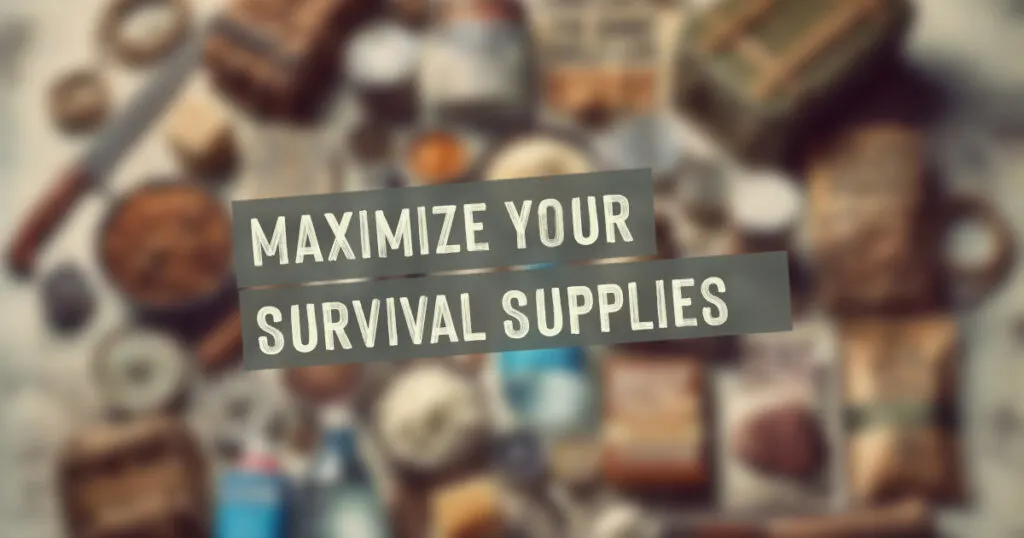
Evaluating Shelf-Stable Foods: A Guide to Checking Quality and Safety
- Canned Goods
- Check For: Bulging, rusting, or leaking cans; a foul odor upon opening; cloudy liquid; or any spurting liquid upon opening.
- How to Check: Inspect the can’s condition before opening. After opening, check for off-odors, discoloration, and the texture of the food.
- Dried Beans and Legumes
- Check For: Mold, pests, or a musty smell; beans that are extremely hard and do not soften when soaked and cooked.
- How to Check: Visually inspect for mold and pests. Soak and cook a small sample to test for unusual hardness or off-flavors.
- Grains and Flours (Wheat, Rice, etc.)
- Check For: Mold, moisture, off-odors, or evidence of pests like weevils.
- How to Check: Look for any discoloration, clumping due to moisture, or small bugs. Smell for any mustiness or unusual odors.
- Powdered Milk
- Check For: Lumps that don’t dissolve easily, a rancid or sour smell, or a yellowish color.
- How to Check: Mix a small amount with water to check for lumps and smell/taste it for freshness.
- Nuts and Seeds
- Check For: Rancidity (a sharp, bitter smell or taste), mold, or pest infestation.
- How to Check: Smell the nuts or seeds first; rancid oils have a very distinctive and unpleasant odor. Look for any mold or insect presence.
- Spices and Herbs
- Check For: Loss of color, aroma, and flavor; any signs of moisture or mold.
- How to Check: Crush a small amount to check if the aroma is still potent. Visually inspect for mold or clumps indicating moisture.
- Oils (Cooking Oils, Olive Oil, etc.)
- Check For: Rancidity, which gives the oil a foul, stale smell or taste.
- How to Check: Smell the oil first; rancid oil has a very distinctive and unpleasant smell. You can also taste a small amount.
- Cured Meats
- Check For: Discoloration, sliminess, off-odors, or mold growth.
- How to Check: Inspect the meat for any changes in color or texture and smell it for any off-odors.
- Condiments (Ketchup, Mustard, etc.)
- Check For: Mold, especially around the rim, separation, or changes in color and smell.
- How to Check: Visually inspect and smell the product. Check the consistency and look for any signs of separation or spoilage.
- Jarred Items (Pickles, Jams, etc.)
- Check For: Mold, off-odors, changes in color or texture, or a lid that pops up (indicating gas production from bacteria).
- How to Check: Look for any visible mold or discoloration and smell the product upon opening. Check if the lid was bulging or popped up when opened.
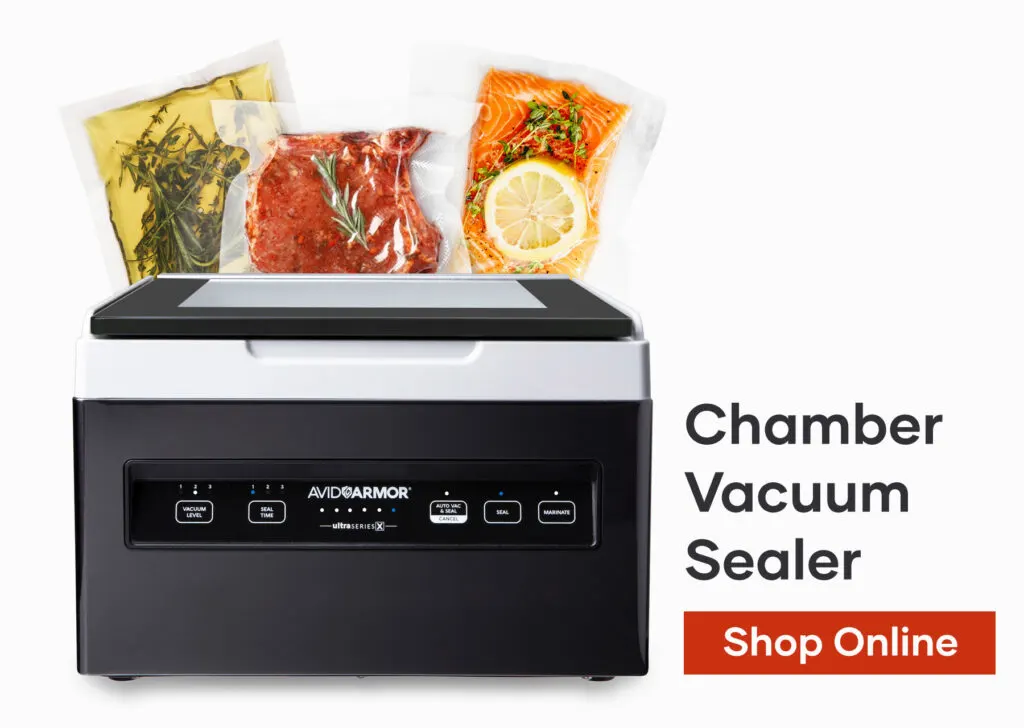
Perishables and Semi-Perishables: How to Assess Freshness and Avoid Spoilage
- Fresh Fruits and Vegetables
- Check For: Soft spots, mold, unusual odors, or significant discoloration.
- How to Check: Feel for softness or mushiness, look for visible mold or rot, and smell for any fermentation or off-odors.
- Cheese
- Check For: Mold (excluding cheeses with intentional mold like blue cheese), sour smell, sliminess, or discoloration.
- How to Check: Visually inspect for unwanted mold and discoloration, smell for off-odors, and feel for a slimy texture.
- Eggs
- Check For: Cracks or leaks in the shell, a sulfuric smell, or an unusual appearance when cracked open.
- How to Check: Perform a float test in water (fresh eggs sink, bad eggs float), check for cracks, and smell after cracking.
- Fresh Meats (Beef, Poultry, Pork)
- Check For: Sliminess, discoloration (green or gray tints), or a foul, rotten smell.
- How to Check: Feel for a sticky or slimy surface, look for color changes, and smell for any off-odors.
- Fish and Seafood
- Check For: A strong, fishy or ammonia-like odor, slimy texture, or dull color.
- How to Check: Smell for freshness (fresh fish should have a mild scent), check for a glossy appearance, and feel for a firm texture.
- Bread and Baked Goods
- Check For: Mold, especially in moist or humid conditions, and staleness.
- How to Check: Look for visible mold, usually green or white spots, and feel for hardness indicating staleness.
- Butter and Margarine
- Check For: Discoloration, sour smell, or a rancid taste.
- How to Check: Look for any color changes, smell for off-odors, and taste a small amount for rancidity.
- Yogurt and Sour Cream
- Check For: Mold, a watery consistency, or a sourer than usual taste.
- How to Check: Look for mold on the surface or sides, check the consistency, and taste a small amount.
- Frozen Foods
- Check For: Freezer burn (white dried-out patches), ice crystals, or a rancid smell in fatty foods.
- How to Check: Visually inspect for freezer burn and ice crystals, and smell once thawed.
- Packaged Snacks (Chips, Crackers)
- Check For: Staleness, moisture inside the package, or an off smell.
- How to Check: Taste a small piece for freshness, feel for any moisture, and smell for any unusual odors.
- Honey
- Check For: Crystallization is normal, but look for any color changes or off-odors.
- How to Check: Observe color and consistency, and smell. Honey rarely spoils but can ferment if water is introduced.
- Chocolate
- Check For: White coating (fat bloom) which is safe, but look for mold or an off smell.
- How to Check: Look for surface changes and smell for any off-odors.
- Cereal and Granola
- Check For: Staleness, moisture, or a rancid smell (especially in cereals with nuts).
- How to Check: Taste a small amount for freshness, feel for moisture, and smell for rancidity.
- Canned Vegetables and Fruits
- Check For: Dents, rust, or swelling in cans, a sour or metallic taste, or a cloudy appearance.
- How to Check: Inspect the can’s condition, smell upon opening, and visually inspect the contents.
- Pasta and Noodles
- Check For: Signs of pests, moisture, mold, or a musty smell.
- How to Check: Visually inspect for bugs or mold, smell for mustiness, and feel for any dampness.
Commonly Stored Food & Their Shelf Life (by the numbers)
- Canned Vegetables
- Recommended Shelf Life: 1-2 years
- Actual Shelf Life: 3-5 years
- Dried Beans
- Recommended Shelf Life: 1-2 years
- Actual Shelf Life: Up to 10 years
- White Rice
- Recommended Shelf Life: 4-5 years
- Actual Shelf Life: 10-30 years (when stored properly)
- Pasta
- Recommended Shelf Life: 1-2 years
- Actual Shelf Life: 2-3 years
- Canned Tuna
- Recommended Shelf Life: 3-5 years
- Actual Shelf Life: 5-10 years
- Powdered Milk
- Recommended Shelf Life: 18-24 months
- Actual Shelf Life: 2-10 years (when stored properly)
- Honey
- Recommended Shelf Life: 2 years
- Actual Shelf Life: Indefinite
- Oats
- Recommended Shelf Life: 1-2 years
- Actual Shelf Life: 2-3 years
- Canned Soups
- Recommended Shelf Life: 2-5 years
- Actual Shelf Life: 5-10 years
- Bottled Water
- Recommended Shelf Life: 2 years
- Actual Shelf Life: Indefinite, but taste may change over time
- Dark Chocolate
- Recommended Shelf Life: 2 years
- Actual Shelf Life: 4-5 years
- Instant Coffee
- Recommended Shelf Life: 2-20 years
- Actual Shelf Life: Indefinite (but flavor quality may diminish)
- Canned Fruit
- Recommended Shelf Life: 1-2 years
- Actual Shelf Life: 2-5 years
- Coconut Oil
- Recommended Shelf Life: 2 years
- Actual Shelf Life: 5 years
- Freeze-Dried Foods
- Recommended Shelf Life: 10-25 years
- Actual Shelf Life: 25-30 years (when stored properly)
- Lentils
- Recommended Shelf Life: 2-3 years
- Actual Shelf Life: Up to 5 years
- Canned Beans
- Recommended Shelf Life: 2-5 years
- Actual Shelf Life: 5-10 years
- Beef Jerky
- Recommended Shelf Life: 1 year
- Actual Shelf Life: 2 years (if unopened and stored properly)
- Peanut Butter (Unopened)
- Recommended Shelf Life: 6-9 months past the “best by” date
- Actual Shelf Life: 2-3 years
- Hard Cheeses (Parmesan, Cheddar)
- Recommended Shelf Life: 3-6 months (once opened)
- Actual Shelf Life: 6-12 months (if stored properly in the fridge)
- Tea Bags
- Recommended Shelf Life: 18-24 months
- Actual Shelf Life: 2-3 years
- Canned Tomato Sauce
- Recommended Shelf Life: 18-24 months
- Actual Shelf Life: 2-5 years
- Maple Syrup (Unopened)
- Recommended Shelf Life: 1 year
- Actual Shelf Life: Indefinite (if unopened and stored in a cool, dark place)
- Soy Sauce (Unopened)
- Recommended Shelf Life: 2-3 years
- Actual Shelf Life: Indefinite (if unopened)
- Vinegar
- Recommended Shelf Life: 2 years
- Actual Shelf Life: Indefinite
- Corn Syrup
- Recommended Shelf Life: 2-3 years
- Actual Shelf Life: Indefinite
- Baking Soda
- Recommended Shelf Life: 2 years
- Actual Shelf Life: Indefinite (but may lose potency over time)
- Cream of Tartar
- Recommended Shelf Life: 3-4 years
- Actual Shelf Life: Indefinite
- Canned Pumpkin
- Recommended Shelf Life: 1-2 years
- Actual Shelf Life: 2-5 years
- Alcohol (Whiskey, Vodka, etc.)
- Recommended Shelf Life: Indefinite (if unopened)
- Actual Shelf Life: Indefinite (quality may change slightly over time)
- Cornstarch
- Recommended Shelf Life: Indefinite
- Actual Shelf Life: Indefinite
- Salt
- Recommended Shelf Life: Indefinite
- Actual Shelf Life: Indefinite
- Sugar (White, Brown, Powdered)
- Recommended Shelf Life: Indefinite
- Actual Shelf Life: Indefinite, though brown sugar can harden
- Pure Vanilla Extract
- Recommended Shelf Life: Indefinite
- Actual Shelf Life: Indefinite
- Rice Vinegar
- Recommended Shelf Life: 2 years
- Actual Shelf Life: Indefinite
- Dried Herbs and Spices
- Recommended Shelf Life: 1-3 years
- Actual Shelf Life: Can last longer but lose potency
The Indefinite Shelf Life: Food Items and Their Uses
For those focused on survival and preparedness, selecting supplies with maximum utility and longevity is essential. This guide lists 15 items that not only have indefinite shelf lives but also serve multiple practical purposes in survival scenarios. These essentials are good for emergency nutrition, first aid, and various tasks. Understanding their varied applications is key for effective emergency preparedness and self-sufficiency. Here, we explore how these items are indispensable in any survival kit.
- Honey: Natural sweetener, cough suppressant, wound and burn treatment, skin moisturizer, hair conditioner, allergy relief (local honey), energy booster
- Bottled Water: Essential hydration, cooking ingredient, emergency sanitation
- Instant Coffee: Quick beverage, baking flavor enhancer, meat tenderizer
- Maple Syrup (Unopened): Alternative sweetener, glaze for meats and vegetables, flavor enhancer in coffee/tea, baking ingredient, homemade granola sweetener
- Soy Sauce (Unopened): Flavor enhancer for various cuisines, meat marinade, stir-fry seasoning, dipping sauce base, salad dressing ingredient
- Vinegar: All-purpose cleaner, fabric softener, hair rinse, skin toner, weed killer, pickling liquid, baking leavening agent
- Corn Syrup: Sweetener in desserts, glaze for baked goods, candy making, ice cream topping, moisture retainer in baked goods
- Baking Soda: Leavening agent, odor neutralizer, surface cleaner, toothpaste ingredient, fire extinguisher, insect bite soother, used in baking powder
- Cream of Tartar: Stabilizer in whipped cream, prevent sugar crystallization in candy, leavening agent when combined with baking soda, homemade playdough
- Alcohol (Whiskey, Vodka, etc.): Cocktail ingredient, flavoring for sauces and marinades, medicinal tincture base, cleaning solvent, fire starter
- Cornstarch: Thickener for soups and sauces, natural laundry starch, grease stain remover, sunburn soother, diaper rash remedy
- Salt: Flavor enhancer, meat brining, stain remover, throat gargle, bath soak, cooking preservative, cleaning abrasive
- Sugar (White, Brown, Powdered): Sweetening agent, caramelizing foods, baking, preserving fruits, body scrub, soothing sore throats (in tea)
- Pure Vanilla Extract: Flavoring in baking and beverages, homemade perfume, air freshener, natural bug repellent, anxiety reliever
- Rice Vinegar: Sushi rice seasoning, pickling vegetables, salad dressing base, meat tenderizer, facial toner, cleaning glass and mirrors
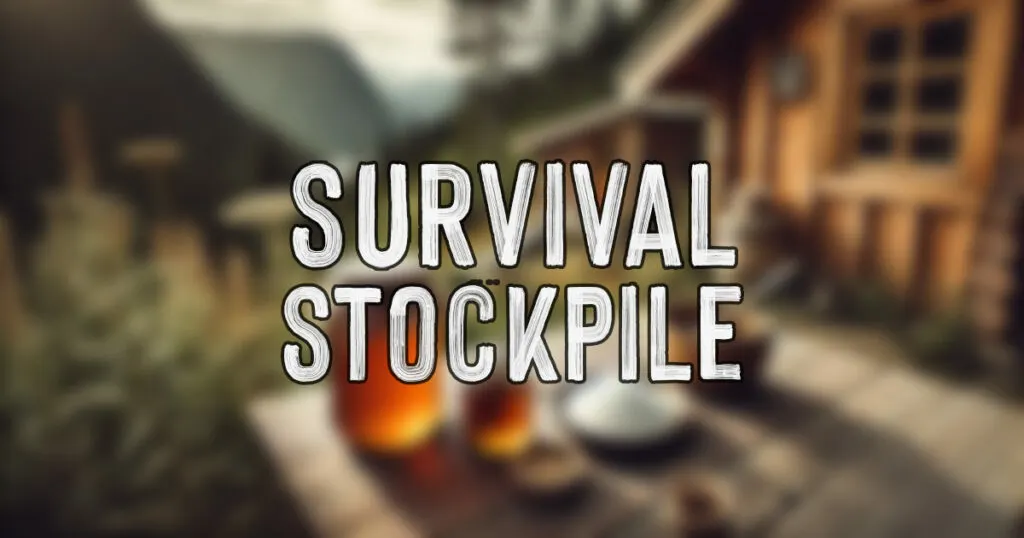
Essential Guidelines for Proper Food Storage: Maximizing Safety and Freshness
Storing food properly is important for maintaining its quality and ensuring safety. Here are some basic rules and information for effective food storage:
Dry Goods (Grains, Beans, Pasta, Flour)
- Environment: Store in a cool, dry place. Ideal temperatures are between 50°F and 70°F.
- Containers: Use airtight containers to protect from moisture and pests. Glass, metal, or plastic containers with tight-fitting lids are suitable.
- Location: Keep away from direct sunlight and sources of heat like stoves or heaters.
Canned Goods
- Temperature: Store in a cool, dry place. Avoid freezing temperatures and extreme heat.
- Shelving: Keep off the floor to protect from pests and moisture. Use a first-in, first-out rotation system.
- Inspection: Regularly check for dents, rust, or bulging, which can indicate spoilage.
Perishables (Meat, Dairy, Produce)
- Refrigeration: Store at temperatures below 40°F. Use the refrigerator’s different compartments as designated (crisper drawers for vegetables, etc.).
- Separation: Keep meats separate from other foods to prevent cross-contamination.
- Timing: Use or freeze perishables before their expiration dates.
Freezing
- Packaging: Use freezer-safe containers or bags. Remove as much air as possible to prevent freezer burn.
- Temperature: Maintain the freezer at 0°F or below.
- Organization: Label and date items. Use a first-in, first-out system.
General Tips
- Inventory Management: Regularly check and rotate your stock. Use older items first and replace them with new ones.
- Hygiene: Keep storage areas clean. Regularly clean shelves, containers, and refrigerators.
- Pest Control: Use pest deterrents and maintain cleanliness to prevent infestations.

Survival Food Safety: Managing Risks and Ensuring Quality in Emergency Situations
In survival or prepping scenarios, consuming outdated or improperly stored food poses significant health risks. This overview details these risks and outlines mitigation strategies:
Risks Associated with Consuming Old Food:
- Food Poisoning: Results from contamination by bacteria, viruses, or parasites. Common symptoms include nausea, vomiting, diarrhea, and fever.
- Botulism: Caused by toxins from Clostridium botulinum bacteria, typically found in improperly canned or preserved foods.
- Chemical Changes: Prolonged storage can lead to the formation of harmful compounds in food.
- Nutrient Degradation: Over time, essential nutrients in food can diminish.
- Allergic Reactions: Decomposition can alter food proteins, potentially triggering allergies.
Assessing Food Quality and Safety:
- Visual Inspection: Look for mold, discoloration, or abnormal textures.
- Smell Test: An off or unusual odor indicates potential spoilage.
- Taste Test: After passing visual and smell tests, a small taste can confirm quality. Discontinue consumption if taste is abnormal.
- Packaging Inspection: Swelling, damage, or compromised integrity suggests contamination.
- Canned Goods: Signs of bulging, rust, or leakage may indicate botulism.
- Expiration Dates: Use as a general guideline, though some foods remain safe beyond these dates.
- Storage History: Evaluate how the food was stored, as improper conditions increase spoilage risk.
Risk Avoidance Strategies:
- Proper Storage: Keep food in cool, dry environments using airtight containers.
- Rotation of Supplies: Implement a first-in, first-out system.
- Preservation Knowledge: Familiarize with safe food preservation methods like canning, drying, and smoking.
- Education: Learn to identify signs of spoilage and foodborne illnesses.
- Emergency Food Stock: Maintain a supply of non-perishable items with extended shelf lives.
- Water Safety: Use clean, safe water for cooking and rehydrating food.
- Cooking Temperatures: Ensure food is cooked to temperatures that eliminate harmful bacteria.
Special Considerations:
- Vulnerable Groups: Infants and the elderly are more prone to foodborne illnesses.
- Chronic Health Conditions: Individuals with certain health issues are more susceptible to the effects of spoiled food.
- Local Resources: In wilderness survival, knowledge of safe preparation of local plants and animals is essential.
Pin this post for later:
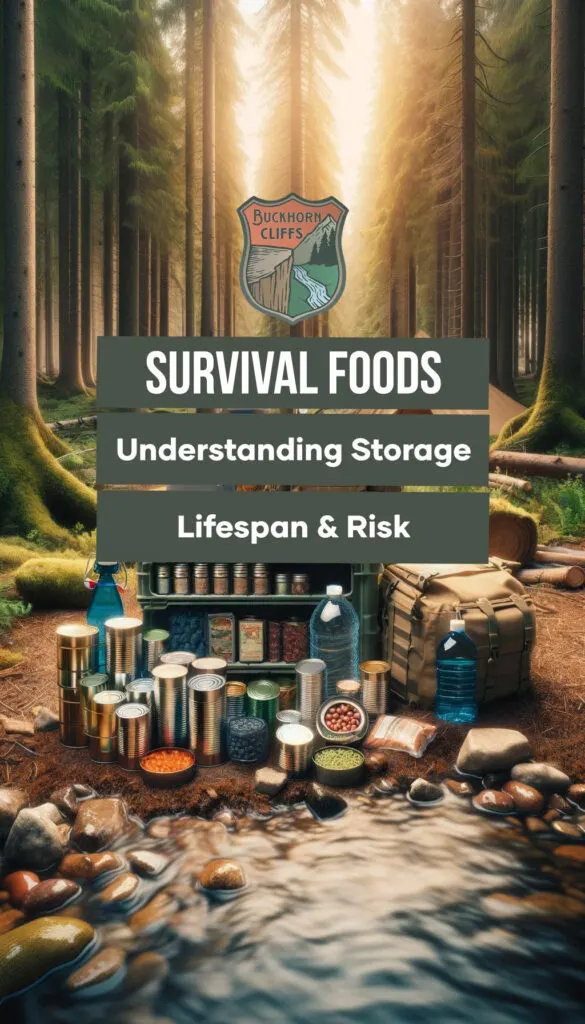

Jeni
Tuesday 17th of June 2025
What is the best way to store drinking water, safely, long term?
Cissy Russell
Tuesday 1st of October 2024
Do you have any idea about solar generators if so which one or ones. Thank you.
Rob Benson
Thursday 3rd of October 2024
Choosing a Home Backup Power System: https://buckhorncliffs.com/home-backup-power-system/
And one that's very small (but useful) https://buckhorncliffs.com/anker-portable-solar-charging/
And midsize: https://buckhorncliffs.com/mid-size-portable-power-station/
Heidi C Pritchard
Wednesday 21st of February 2024
Great and helpful list Robby. I appreciate it and am thankful I found your Instagram page.
Rob Benson
Wednesday 21st of February 2024
Thank you!
Stacey
Monday 15th of January 2024
Can canned goods (as long as they are not bulging and rusty and seal broken ) have. A shelf life of 25 years? How about canned glass jar items? Thank you for all your helpful information.
Rob Benson
Monday 15th of January 2024
High-acid foods like tomatoes and fruits typically have a shorter shelf life, around 1-5 years, while low-acid foods like meat and vegetables can last much longer.
Items canned in glass jars can also have a long shelf life. The same rules apply: the seals must be intact, and the jars should be stored in cool, dark, and dry conditions. Again, the longevity will depend on the type of food and the acidity level. Glass has the advantage of not corroding like metal.
sandy
Friday 5th of January 2024
Very thorough list. Thank you. I follow your information on Instagram. Ive got a decent food and water supply for the family of two and large dog. Now I am focused on other details and your attention to detail really helps. I really appreciate it.
Rob Benson
Saturday 6th of January 2024
That's great, thank you!